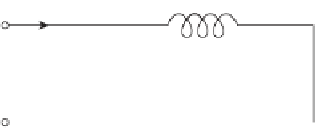Environmental Engineering Reference
In-Depth Information
I
2
R
2
jX
2
1 - S
S
E
2
R
2
-----
Figure 4.13
Equivalent circuit of induction machine rotor
Air gap
R
1
X
1
R
2
X
2
1 - S
S
V
1
E
1
E
2
R
2
-----
Ideal transformer
Figure 4.14
Induction machine stator - rotor equivalent circuit
induced voltage is
sE
2
, the rotor frequency is
sf
and the rotor reactance is
sX
2
. For the rotor
current at slip
s
we can write the more general expression:
s
E
E
E
2
2
2
I
=
=
=
(4.20)
2
(
)
+
[
(
)
]
+
R
+
jsX
R
s
jX
R
+
R
1
−
s
s
jX
2
2
2
2
2
2
2
since
R
/
s
=
R
2
+
R
2
[(1
s
)/
s
] .
Equation (4.20) provides the rational for the equivalent circuit shown in Figure 4.13. This
circuit resembles that of the secondary winding of the transformer (Figure 4.10) but with a
variable resistive load connected to its output. The energy conservation principle indicates
that the electrical power transferred to the rotor is the real part of
E
2
*
. The power lost irre-
versibly in the rotor ohmic resistance is
R
2
2
and the remainder, i.e.
IR
−
[
(
)
]
2
1
−
s s
, must be
2
and indeed is the electrical power converted into mechanical power.
The transformer equivalent circuit analogy is extended in Figure 4.14 to include the stator
parameters. Here
R
1
and
X
1
represent the stator winding resistance and inductance while
X
m
represents the magnetizing reactance drawing the current necessary to establish the RMF.
The dashed line corresponds to the air gap interface across which energy is transferred from
the stator to the rotor.
In a further simplifi cation the ideal transformer can be omitted by transferring elements
from secondary to primary using the transformation ratio. In Figure 4.15
R
s
and
X
s
are the
stator winding resistance and reactance respectively. The elements
R
r
and
X
r
represent the
rotor resistance and reactance respectively referred to the stator using the rotor-stator trans-
formation ratio. The product
Rs
[
(
)
]
=
R
em
represents the electrical power per-phase
converted into mechanical power. This equivalent circuit tells us that when the rotor is locked,
s = 1,
R
r
[(1
1
−
s I
2
r
s
1 ,
the energy into the rotor is partly converted into heat in the winding resistances and partly
into mechanical form.
−
s
)/
s
] = 0, so all the input to the rotor is converted into heat in
R
r
. When s
<



















